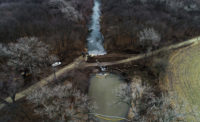Oil Spills
Accidental Louisiana Pipeline Rupture Interrupts Shore Restoration Job
Subcontractor Reportedly Cut Pipeline While On Job Financed by BP Settlement

An accidental oil spill temporarily slowed a shoreline restoration project in Louisiana. Photo: Jonathan Henderson, VanishingEarth.org. Flight provided by SouthWings.org.
Great Lakes Dredge & Dock Co. has resumed work on an environmental restoration project on the Louisiana coast after halting operations when a subcontractor apparently accidentally ruptured an oil pipeline.
The project was being paid for as part of the settlement following the Deepwater Horizon disaster of April 2010.
Great Lakes was overseeing the restoration of Chenier Ronquille, a barrier island by Bay Long, when disaster struck on September 5.
A marsh excavator buggy operated by a subcontractor tracked over a pipeline owned by Harvest Pipeline Co., an affiliate of Houston-based Hilcorp Energy, pumping 5,300 gallons of crude oil into the Gulf of Mexico.
Officials of Great Lakes Dredge and Dock Co., the big dredging and coastal restoration contractor based in Oakbrook, Ill., could not be reached for comment.
The accident triggered an intensive cleanup operation by the U.S. Coast Guard and other state and federal agencies.
Now the focus has shifted back to the island rebuilding project that the pipeline rupture temporarily shut down, according to a spokesman of the National Oceanic and Atmospheric Administration.
“The project itself has resumed and we are currently working on bringing in the material needed to construct the marsh habitat portion of the project,” wrote Ben Sherman, director for communications for the National Oceanic and Atmospheric Administration, which is overseeing the work.
BP is picking up the tab for the $36- Chenier Ronquille rebuilding project, part of $1 billion the company pledged in the aftermath of the disaster. The money is being used for restoration projects on the Louisiana coast. (BP also agreed to pay another $7.1 billion for environmental caused by the 2010 oil rig explosion and the massive spill it caused as part of settlements with the federal and state governments.)
In addition to filling in breaches carved out by hurricanes, the work on Chenier Ronquille also involves rebuilding dunes and marshland as well.
Still, it’s not clear yet who will be footing the bill for the mess caused by the pipeline rupture by the Great Lakes subcontractor, though hopefully there is some robust pollution insurance coverage in place.
However, the cleanup certainly wasn’t inexpensive.
Crews managed to remove more than 6,000 gallons of “oily-water mixture” in the week after the spill, according to a press statement by the U.S. Coast Guard.
The cleanup operation involved “155 personnel, 25 boats, 7 skimmers, and more than 12,000 feet of hard-boom,” the Coast Guard reports.
Oil also made it onto the island itself, including into some of the depressions on the island that were part of the restoration project, The Times-Picayune reported, citing aerial photos taken of the island by an environmental group. As many as 200 birds were oiled, Coast Guard officials have said.





